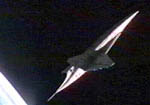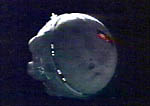|
In making 2001: A Space Odyssey, director/co-writer Stanley Kubrick's goal was to create the quintessential sci-fi film. Using Arthur C. Clarke's short story, The Sentinel, as a starting point, Kubrick and Clarke crafted a sophisticated tale of first contact. Even decades after its creation this film remains an unchallenged sci-fi landmark. Kubrick's goal in portraying 2001's technology was "absolute realism". Never before (and probably never since) have fictional spacecraft designs with such solid real-world aerospace foundations been portrayed on the big screen. This is due in large part to Harry Lange and Fred Ordway. Both men came from the aerospace field and were green with respect to cinema. Lange designed most of the hardware, with Ordway providing technical support. They tackled the job with even more enthusiasm than Kubrick had hoped. In the early eighties Clarke decided to write a sequel, 2010: Odyssey Two. Clarke's efforts eventually turned into a four-book series. 2010 was almost immediately optioned into a film, which was directed by Peter Hyams. Many dedicated 2001 fans found the sequel to be a disappointment. Cinematic technique aside, the spacecraft, designed by futurist Syd Mead, lacked the solid aerospace foundations of Lange's original work. The Leonov's appearance is tempered more by the image of 80's mainstream sci-fi cinema than logical aerospace engineering. Modeling subjects from 2001 presents a unique challenge. Once production on the film concluded, Kubrick ordered all the models, sets, and plans destroyed. He'd seen too many quality sci-fi films become trivialized by use of their props by later B-movie productions. As a result, the most complete reference source for the ships of 2001 is the film, itself. This leads to a certain amount of detective work on the modeler's part, as the film gives only limited views of the craft. Upon release of the film there were only three plastic scale models made: Aurora's Moonbus and Orion III, and Airfix's (less accurate) Orion III. More and improved subjects waited until the advent of the resin garage kit, in the late '80's. The cottage industry revolution opened the doors to a flood of new models, though few to none are officially licensed products. As a result they are low production runs and are usually available only through the manufacturer. |
2001:
Orion III |
Space Station 5 |
Aries IB |
Moonbus |
Discovery I |
Pods |
Space Suits
2010:
Leonov
General:
2001/2010 Links |
2001 Reference Page
2001: A Space Odyssey |
 |
Orion III. The Orion III "Space Clipper" is a reusable spaceplane. In the world of Kubrick's 2001, commercial concerns have taken over the routine task of shuttling people to orbit and to our bases on the Moon. The (now defunct) Pan American airlines was the courier using the Orion III to transport Dr. Floyd to Space Station 5. In Clarke's novel, he describes a winged orbital assist stage that detaches and flies back to Earth. One of Lange's illustrations shows the rear "booster" part of the Orion (the section aft of the retro ring, including the aft wing area) detaching and falling away. The former may have still been part of the final concept, but the latter is clearly not, as we see the Orion reach orbit as one piece. |
|
References:
|
Reviews:
|
 |
Space Station 5. Still under construction, Space Station 5 is Earth's largest orbital structure, to date. It serves as both an orbital destination, as well as a transfer point for all international travelers venturing to the Moon. The station rotates to simulate gravity at the perimeter of its twin ring structure. The spacecraft docking facilities are the the station's axial core. Many of the pleasantries expected by civilized travelers are present on Space Station 5, including hotels, restaurants, pay phones, and the like. |
|
References: |
Reviews:
|
 |
Aries IB. Also operated by Pan American, the Aries IB is a craft which routinely shuttles passengers between Earth orbit and the lunar surface. It sports retractable landing gear which lets it to tail-land on the Moon. The vessel's cockpit is on the "top" to the spherical hull and the passenger deck lies at the hull's "equator". Passengers may rest in their comfortable couches and/or watch large-screen AV presentations to kill the time during their transit. The landing pads at Clavius Base house elevators which can deliver the landed Aries to a subsurface hanger. |
|
References:
|
Reviews:
|
 |
Moonbus. The Moonbus is a lunar surface shuttle which, in the 2001 story, transports Dr. Floyd and his associates from Clavius Base to the TMA-1 research outpost within the crater Tycho. The vehicle is a simple transport which hovers off the surface using six engines mounted in the base of the craft. These may be gimbaled to supply some forward momentum and steering, as well. The primary steering mechanisms are two RCS thruster units, mounted in housings about a third of the way back from the nose. |
|
References: |
Reviews:
|
 |
Discovery 1 (XD-1). When the TMA-1 artifact began beaming signals towards Jupiter, the USAA pushed ahead with Project Discovery. Discovery One would be the first manned mission to Jupiter. Its true mission - to determine the target of TMA-1's transmissions - was kept secret from both the public and the crew. Discovery One was a nuclear-powered craft, almost 400 feet in length. A spherical command module rested at the front of the vessel. Within this sphere lay the crew space, an internal centrifuge habitat, and an EVA Pod bay (holding three Pods). Discovery One was left in orbit about Io when Commander Bowman disappeared within the large monolith near Jupiter. |
|
References:
|
Reviews:
|
 |
Pods. Discovery carried three, one-man EVA pods. According to Clarke, these carried the nicknames "Anna","Betty" and "Clara" (A, B, and C). These launched from the Pod bay, at the front of the command module. Each Pod is outfitted with two, twin-clawed manipulator arms. The Pods may be driven by the pilot, or can be controlled directly by Discovery's on board AI computer, HAL 9000. This way the HAL piloted Pod can assist a free floating astronaut during repairs... or sneak up on them and rip out their air hose, though that feature was not part of the original design spec... |
|
References:
|
Reviews:
|
 |
Spacesuits. The spacesuits of 2001 featured a more elegant, streamlined design than those being employed by the Apollo astronauts of the time. The film's clamshell helmet design is one of the suit's most notable features. Its unusual shape is rumored to be inspired by cloth caps favored by hardware designer, Lange. The panels on the back of the helmet are interchangeable, mission-specific modules. Color aside, the suits seen on the Moon, and later on Discovery, are very similar in design. There are different modules on the back of the helmet, and the Discovery astronauts carried an optional EVA maneuvering pack. |
|
References: |
Reviews:
|
2010: The Year We Make Contact |
 |
Leonov. Named after cosmonaut Alexi Leonov (first spacewalker, would-be first Russian on the Moon, and commander of Apollo-Soyuz), this craft was launched by the Soviets (Clarke's timeline did not predict the downfall of the Soviet Union) to travel to Jupiter and board Discovery One. The film design of the ship differed from that in Clarke's novel. Under Hyam's direction, Leonov became a vessel mounting large, opposing habitat centrifuges and inflatable heat-shielding "ballutes" for aerobraking. Like Discovery One, it carried a fleet of EVA pods (though substantially different in design). |
|
References: |
Reviews:
|
Reference:
|
![]()
2001 is ©1968 Turner Entertainment Co. and 2010 is ©1984 Turner Entertainment Co., all rights reserved.
This page made possible by Starship Modeler - © 1997-2013
Last updated on 21 June 2013